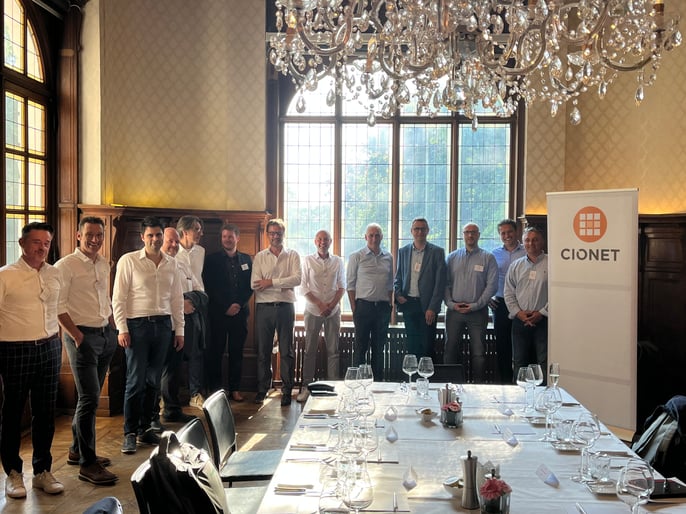Twelve digital leaders - from CIOs, CTOs, to heads of enterprise architecture, DevOps, or applications - gathered last Tuesday (6th June) at the beautiful Tivoli castle in Mechelen to exchange their views, best practices, and experiences with the use of low-code.
Why use low-code? The common denominator of the answers to this question was undeniably the need to meet the ever-increasing pace of demand for new developments or changes from the business, or rather, from the market. The context needs to be seen in a broader sense: the organisation is undergoing its digital transformation, and in that context, IT needs to guide the business in keeping up with, or ideally staying ahead of, market demand. Speed and flexibility are crucial. Business and IT must play closely together. And here, low-code can indeed make a significant contribution.
"Faster, better, cheaper”, expressed Peter Winkelmans, Head of Enterprise Architects at Carrefour, describing how IT should deliver within their highly demanding retail environment. "The focus is mainly on the front end; the interaction with end customers. We develop at a rapid pace to meet customer needs. Not only do these needs change very quickly, but the competition is also fierce. The entire sector is constantly under high pressure, and here the adage 'survival of the fittest' applies, where 'fittest' primarily refers to the ability to adapt quickly and flexibly. Low-code is a strategic tool for us that allows us to adapt our application environment quickly and easily in collaboration with the business, and to capitalise on the enormous volumes of data we have. And since the low-code platform is fully cloud-based, all infrastructure concerns are immediately eliminated."

Sigurd Segers, Director Applications, EA & Analytics at Terumo, fully recognized this story. "Terumo has been an experienced user of low-code since 2019. Everything has been migrated to the cloud, and low-code has allowed us to keep our code clean. Our next step is to develop customer-facing apps using low-code. It enables us to go the extra mile in customization. Off-the-shelf applications may seem to offer the same at first glance, but when it comes down to it, you invest just as much time and end up with a set of applications that are all slightly different and make maintenance a challenge."
"Thanks to low-code, we can effectively bring consistency. We offer the same look and feel to our people on the shop floor," affirmed Steven Vansteenkiste, IT applications manager - Manufacturing at Etex. This consistency is highly appreciated by both the users and the people responsible for maintaining it.
-2.jpg?width=428&height=321&name=unnamed%20(2)-2.jpg)
"On December 6, the city of Antwerp fell victim to a cyber-attack. As the IT partner of the city, Digipolis is still working hard to get all systems and applications up and running again. In this regard, we are also considering low-code to expedite the recovery. Of course, security receives considerable attention, especially since some of the organizations involved fall under the category of 'critical infrastructure' and must be compliant with the NIS2 regulations. Therefore, we primarily aim to build or rebuild secure applications in a fast and agile manner. The waiting list is long. Standardisation and low-code development can be part of the answer," according to Gert De Laet, Enterprise Architect at Digipolis.
Ivan Verstraeten, Director IT - Network applications and OSS, admitted that they coincidentally adopted low-code when they chose "Expert Desk," the ticketing system based on the Mendix low-code platform, after an in-depth benchmark study. "The choice was made based on the covered functionalities, the flexibility it allowed, and of course, the price. The low-code development is done in collaboration with an external partner. Even before development takes place, the first step is to standardise the processes involved. This is a crucial job tackled by mixed teams at Telenet. Key users, who also take on the role of ambassadors, are included in these teams to later involve other users. Considering the positive results of working with low-code for the ticketing system, we are now considering bringing a low-code platform in-house to clean up the diversity of the current application environment in a future phase."
"Dekra has been an early adopter of low-code," stated Tom Saudemont, Head of DevOps - Claims Management at Dekra. Dekra is an organisation with 49,000 employees, globally active in the TIC sector, where TIC stands for Testing, Inspection, and Certification. "We have been using Mendix since 2015 when low-code was still a relatively unknown concept. We built twelve applications on the platform. Only twelve, indeed, but these are business-critical systems with very high complexity. One of the lessons learned relates to this. When we built the core application for ACE - Automotive Claims & Expertise - the business demanded that it be globally reusable. However, in practice, this proved not to be possible due to the regional differences typical of the ACE domain. The solution that emerged was to build basic components that each country could use to build its own version. Each country can simultaneously make suggestions for expanding the functionality of the basic apps, which are centrally decided by a governance board."
.jpg?width=447&height=335&name=unnamed%20(3).jpg) For Tom, the major challenge was not so much working with low-code, but rather getting the organisation to accept the agile way of working. The concept of a Minimum Viable Product (MVP) is still difficult for many business users to grasp. Additionally, integrating the business into the IT landscape is not a given. As an IT professional, you have to accept that ownership lies with the business. The budget comes from them. They decide on the "what," while IT decides on the "how." Bringing business colleagues to the development table, as citizen development proposes, is a step too far according to Tom. Even with low-code, a good technical background and a basic understanding of development logic are essential. However, low-code's visual interface does facilitate better communication with business colleagues. Together, you review the mapped-out processes, present them with prototypes more quickly, conduct short iterations, and make improvements. This effectively accelerates the entire process and brings the parties closer together by enhancing their mutual understanding of each other's jobs.
For Tom, the major challenge was not so much working with low-code, but rather getting the organisation to accept the agile way of working. The concept of a Minimum Viable Product (MVP) is still difficult for many business users to grasp. Additionally, integrating the business into the IT landscape is not a given. As an IT professional, you have to accept that ownership lies with the business. The budget comes from them. They decide on the "what," while IT decides on the "how." Bringing business colleagues to the development table, as citizen development proposes, is a step too far according to Tom. Even with low-code, a good technical background and a basic understanding of development logic are essential. However, low-code's visual interface does facilitate better communication with business colleagues. Together, you review the mapped-out processes, present them with prototypes more quickly, conduct short iterations, and make improvements. This effectively accelerates the entire process and brings the parties closer together by enhancing their mutual understanding of each other's jobs.
The ultimate conclusion is indeed that low-code is not the holy grail that solves all development problems. Because even in a perfect development platform, you can still create poor applications. However, a good low-code platform facilitates collaboration between IT and the business. It enables the translation of a business problem into a software solution. It removes many technical obstacles. And as Wijnand Pauwelijn, Enterprise Account Executive at Mendix, put it, "Low-code is a powerful tool in the hands of optimists, of people with a 'can-do' mentality enabling them to overcome many (business and IT) obstacles."
Special thanks to our partner Mendix for the pleasant and constructive collaboration, to Tom Saudemont and Ivan Verstraeten for their personal testimonies, and to all participants in this captivating round table.



-2.jpg?width=428&height=321&name=unnamed%20(2)-2.jpg) "On December 6, the city of Antwerp fell victim to a cyber-attack. As the IT partner of the city, Digipolis is still working hard to get all systems and applications up and running again. In this regard, we are also considering low-code to expedite the recovery. Of course, security receives considerable attention, especially since some of the organizations involved fall under the category of 'critical infrastructure' and must be compliant with the NIS2 regulations. Therefore, we primarily aim to build or rebuild secure applications in a fast and agile manner. The waiting list is long. Standardisation and low-code development can be part of the answer," according to Gert De Laet, Enterprise Architect at Digipolis.
"On December 6, the city of Antwerp fell victim to a cyber-attack. As the IT partner of the city, Digipolis is still working hard to get all systems and applications up and running again. In this regard, we are also considering low-code to expedite the recovery. Of course, security receives considerable attention, especially since some of the organizations involved fall under the category of 'critical infrastructure' and must be compliant with the NIS2 regulations. Therefore, we primarily aim to build or rebuild secure applications in a fast and agile manner. The waiting list is long. Standardisation and low-code development can be part of the answer," according to Gert De Laet, Enterprise Architect at Digipolis.
.jpg?width=447&height=335&name=unnamed%20(3).jpg) For Tom, the major challenge was not so much working with low-code, but rather getting the organisation to accept the agile way of working. The concept of a Minimum Viable Product (MVP) is still difficult for many business users to grasp. Additionally, integrating the business into the IT landscape is not a given. As an IT professional, you have to accept that ownership lies with the business. The budget comes from them. They decide on the "what," while IT decides on the "how." Bringing business colleagues to the development table, as citizen development proposes, is a step too far according to Tom. Even with low-code, a good technical background and a basic understanding of development logic are essential. However, low-code's visual interface does facilitate better communication with business colleagues. Together, you review the mapped-out processes, present them with prototypes more quickly, conduct short iterations, and make improvements. This effectively accelerates the entire process and brings the parties closer together by enhancing their mutual understanding of each other's jobs.
For Tom, the major challenge was not so much working with low-code, but rather getting the organisation to accept the agile way of working. The concept of a Minimum Viable Product (MVP) is still difficult for many business users to grasp. Additionally, integrating the business into the IT landscape is not a given. As an IT professional, you have to accept that ownership lies with the business. The budget comes from them. They decide on the "what," while IT decides on the "how." Bringing business colleagues to the development table, as citizen development proposes, is a step too far according to Tom. Even with low-code, a good technical background and a basic understanding of development logic are essential. However, low-code's visual interface does facilitate better communication with business colleagues. Together, you review the mapped-out processes, present them with prototypes more quickly, conduct short iterations, and make improvements. This effectively accelerates the entire process and brings the parties closer together by enhancing their mutual understanding of each other's jobs.
No Comments Yet
Let us know what you think